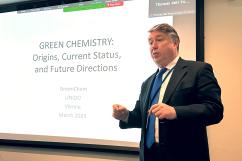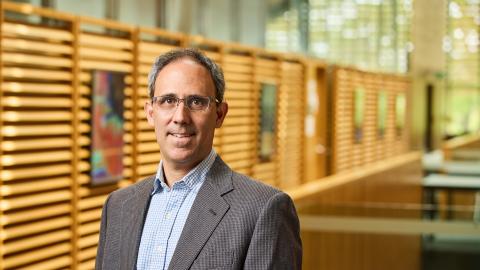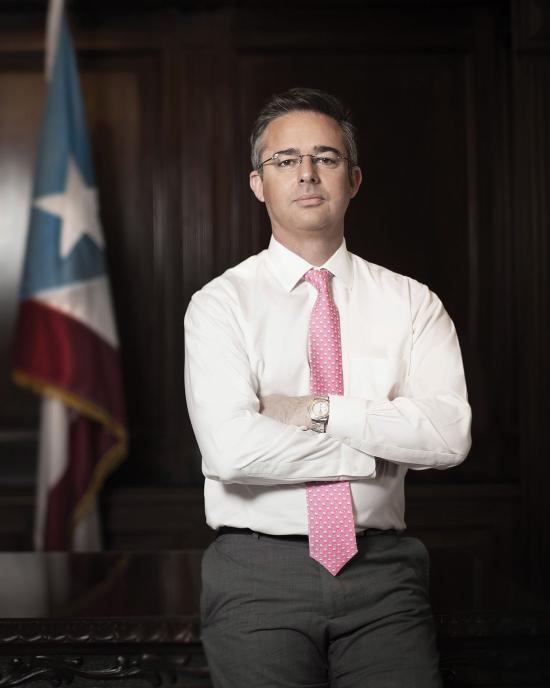

Representatives from the six countries participating in the Global Greenchem Innovation and Network Programme gather at UNIDO headquarters in Vienna, Austria, on March 14, 2023, for a two-day conference. Left to right: Ailsa Eidet (UNIDO), Marcos Alegre Chang (Peru), Husam Alkilany (Jordan), Ignatius Warsito (Indonesia), Paul Anastas (Yale), Rodica Ivan (UNIDO), Maricé Salvador (Peru), Branko Dunjic (Serbia), Karolina Mellor (Yale), Olena Tabachuk (Ukraine), Nunsi Bella Pranatiwi (Indonesia), Lars Ratjen (Yale), Matthew Moroney (Yale), Peter Ssekajja (Uganda), and Raditya Eka Permana (Indonesia).
Scaling Up Green Chemistry Globally for a Sustainable Future
Uganda’s textile and apparel industry is a major exporter to the world and a main source of income for more than 250,000 households and 5,000 workers in the country. But the textile sector has been reliant on flame retardants that contain highly problematic persistent organic pollutants (POPs) — “forever chemicals” that don’t break down easily and can be harmful to human and ecosystem health.
In Jordan, the building sector is growing rapidly to meet the demands of its increasing population growth at the same time as climate change has pushed temperatures to new highs in the region. This has resulted in a need for the country to produce more fire-resistant insulation. The insulation, however, contains halogenated flame retardants and other POPs.
“The Yale-UNIDO collaboration is working to address the burdens of historically harmful chemicals and industrial practices from the Global North, which have a disproportionate impact in emerging nations, and bringing the benefits of green chemistry to the places in the Global South that have suffered the worst effects of unsustainable chemistry practices.”
Program Coordinator
These two countries are part of a new initiative led by the Center for Green Chemistry and Green Engineering at Yale (CGCGE) and the United Nations Industrial Development Organization (UNIDO) that will help reduce the use of hazardous chemicals worldwide. With a $12.6 million grant from the Global Environment Facility, the Global Greenchem Innovation and Network Programme will establish accelerator programs in emerging nations to reduce POPs and greenhouse gas emissions and develop a single global network that will connect stakeholders seeking to implement green chemistry and green engineering alternatives.
“If the benefits of green chemistry are going to be realized by everyone in the world, green chemistry needs to be practiced by everyone. And this is exactly what this initiative is trying to achieve,” says Karolina Mellor, program director of the Global Greenchem Innovation and Network Programme. “We are starting with six focus countries who are seeking to transition to cleaner manufacturing and industrial practices and the intent is to scale up.”
As countries across the globe invest in their economies and ramp up their industry and manufacturing base, they can avoid the harmful chemicals that have left legacies of pollutants from past manufacturing practices —and current ones —with the help of this new project, the YSE team notes.
“The Yale-UNIDO collaboration is working to address the burdens of historically harmful chemicals and industrial practices from the Global North, which have a disproportionate impact in emerging nations, and bringing the benefits of green chemistry to the places in the Global South that have suffered the worst effects of unsustainable chemistry practices,” says Hannah Feldman, program coordinator for the initiative. “We can take concrete steps to prevent these unsustainable processes from becoming further ingrained and almost irreversible.”
Along with Uganda and Jordan, other participating countries are Peru, Serbia, Ukraine, and Indonesia. While each country will focus on a specific industry, their aim is the same: eliminating POPs, mercury and microplastics, and reducing greenhouse gas emissions.
The Glue
The field of green chemistry emerged in 1991, when YSE’s Paul Anastas, Teresa and H. John Heinz III Professor in the Practice of Chemistry for the Environment, coined the term “green chemistry” and launched the first research program with this clear definition: “the design of chemical products and processes that reduce or eliminate the use and generation of hazardous substances.”
Anastas is known as the father of green chemistry and directs the Center for Green Chemistry and Green Engineering at Yale. Noting his motivation to alert the world to safer alternatives, he has said in previous interviews, “Looking back over two centuries of chemistry, there has always been this creative tradition of coming up with new ways of doing things that transform the quality of life. Green chemistry is building on that. It says that we can do better. It says that not only can we achieve all of that function and performance, but we can do it in a way that’s fundamentally sustainable, nontoxic, and renewable rather than degrading.”

While the field has continued to grow and nations across the world have developed regulations to cut down on hazardous chemicals, connecting chemists, academics, policymakers, and industry leaders across the globe is not easy. Add to that the more than 350,000 chemicals and mixtures registered for production across the world, and the transition to green chemicals can seem daunting.
“The problem is that all of these networks are very disjointed,” Mellor says. “We envision a platform connecting everybody working in green chemistry that also embraces those who don’t have the resources or avenues to share and learn. This new network will be the glue that binds the field together,” she says.
Partners in the project include the American Chemical Society, ACS Green Chemistry Institute, Beyond Benign, and the National Cleaner Production Centers.
Duplication and Expansion
Stakeholders in the partnering countries say it is not a lack of desire to change to safer chemicals and processes, it is often a lack of awareness of safer alternatives, lack of access to green chemicals, and fear of financial risks.
“One issue will be to make clear to the industries that participating in a green transition will give them a steppingstone to new markets,” says Almoayied Assayed, director of the Royal Scientific Society’s Water, Environment and Climate Change Centre in Jordan.
The new accelerator program will select and fund pilot projects and startups in each of the six participating countries that will address worldwide goals for reducing and eliminating POPs, mercury, microplastics, and greenhouse gas emissions in the manufacturing and production process. Key to the projects that get funded is their ability to be replicated across the world.
“Major companies are coming under new legislation where they must consider sustainability. Green chemistry is stepping in to bring its ideas to the chemistry community as a whole so it can be adapted everywhere,” says Lars Ratjen, CGCGE associate research scientist and program manager for the UNIDO-YSE collaboration.
“One of the challenges is balance. How do we move toward greening the sector while remaining competitive?”
Director of the Uganda Cleaner Production Centre
In Jordan, which needs to construct 50,000 new housing units per year, the accelerator program will help the building sector not only provide healthier insulation options but also access new markets and promote new green policies and regulations.
“We are an economic hub and have an effect on our region. We can exchange our experiences with our neighboring countries, and our companies will be able to expand regionally and internationally,” Assayed says.
Uganda was one of 152 countries to ratify the Stockholm Convention that entered into force in 2004. The country’s leaders also signed the Kyoto Protocol, the Paris Agreement, and the U.N. Framework Convention on Climate Change. But Uganda’s transition to safer and sustainable manufacturing in the textile industry has been slow because of myriad obstacles that keep it reliant on the use of POPs, including perfluoroalkyl and polyfluoroalkyl substances (PFAS).
“One of the challenges is balance. How do we move toward greening the sector while remaining competitive? It’s very expensive for local producers and investors to transition to new technology when there is limited access to financing. Additionally, the textile factories are very old and there may not be awareness of the risks and restrictions of POPs. There is limited access to alternatives, and the legal framework is not in place to facilitate promotion of green chemistry,” says Silver Ssebagala, director of the Uganda Cleaner Production Centre.
Ssebagala says the accelerator program will spur new buy-in from textile companies to transition to safer alternatives by providing startup funding that will allow companies to enter new markets and grow.
The greening of the textile industry will have ripple effects throughout the country, Ssebagala says. The growth of the textile industry will enhance government revenue and help eliminate poverty in Uganda while also reducing pollution and minimizing health and environmental hazards.
“We need to move together toward green growth. We need to assist entrepreneurs and investors who want to change from these polluting chemicals,” Ssebagala says. “Once the process happens in a green factory, there will be opportunities for all the factories in the sector and in the region. There will be a business model that can be duplicated.”



